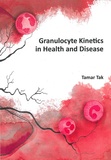Granulocyte kinetics in health and disease

Tak, Tamar
- Promoter:
- Prof.dr. L. (Leo) Koenderman
- Co-promoter:
- Dr. J.A.M. (José) Borghans & dr. N.A. (Kiki) Tesselaar
- Research group:
- Koenderman , Borghans Tesselaar
- Date:
- May 31, 2016
- Time:
- 12:45 h
Summary
The innate immune system is indispensable for defence against pathogens. Yet, little is known about the behaviour of innate immune cells in the body. For example, there is little consensus regarding the circulatory lifespans of neutrophils, eosinophils and basophils in healthy individuals. For the lifespans and behaviour of these cells in tissues and in acute or chronic inflammation, no information is available at all. Without this knowledge, it is very difficult to interpret and design clinical trial targeting these cells.
Therefore, we estimated the circulatory lifespans of neutrophils, eosinophils and basophils in healthy controls by use of in vivo deuterium labelling. This method allows labelling of these cells without any toxic side-effects or manipulation. Hereby, we estimate that these cells remain longer in the bloodstream than previously anticipated.
In addition to estimating circulatory lifespans, this technique can also be used to gain information of the developmental relationships between immune cells. For example, three different subsets of monocytes are recognised in the circulation, but it is uncertain whether these three subsets represent a different maturation stage of the same cell or whether they are all three different cell developing separately in the bone marrow. By combining deuterium labelling results with mathematical modelling, we show that the three monocyte subsets can be different maturation stages of the same cell, but only if part of this process takes place outside of the bloodstream and if only few cells mature into all three different subsets.
Similarly, three neutrophil subsets have been identified, although these three subsets are only seen during acute inflammation. Using the same methodology, but combined with state-of-the-art proteomics, we suggest that one of the three neutrophil subsets develops separately from the others. This immunomodulatory, hypersegmented neutrophil subset is set apart from the other two based on its proteome, whilst having similar deuterium labelling kinetics.
Lastly, the behaviour of neutrophils and eosinophils are assessed in the blood and lungs of patients with asthma and cystic fibrosis (CF). We have concluded in the lungs of asthma patients, that once these cells are present in the lungs, they are in a severely active state. This is regardless the inflammatory asthma phenotype. Regarding the life-cycle of these cells in the blood of CF and asthma patients, we show that the behaviour of neutrophils is severely affected in the blood of CF patients, whereas for asthma patients, eosinophils behave very different compared to healthy controls. In the lungs, we show neutrophils to be very short-lived cells, regardless of the type of disease. For eosinophils, we show clues that they may actually be long-lived cells in the lungs.
Taken together, this thesis provides critical insight in the behaviour of innate immune cells under both healthy and diseased conditions and will help interpreting and predicting how they will behave in response to intervention studies.